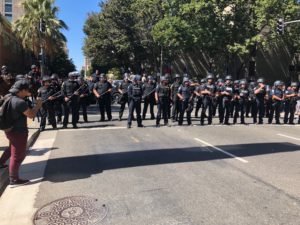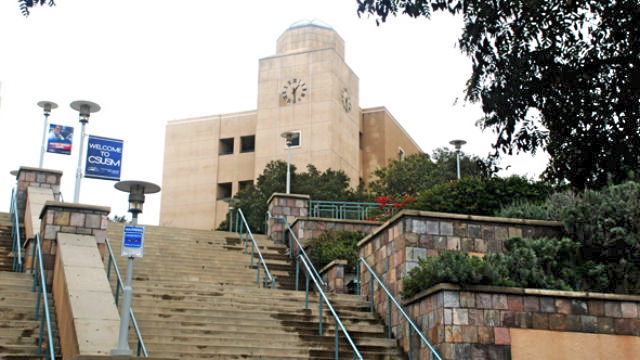Daily Business Report-Aug. 21, 2019
Legalization hasn’t ended California’s black market for marijuana.
Legal cannabis sales in California
to reach $3.1 billion in 2019
Legal cannabis sales in California will reach $3.1 billion this year, making the state the world’s largest legal marijuana market, The L.A. Times reported based on information provided by Arcview Market Research and BDS Analytics.
California’s black market for marijuana continues to flourish, with an estimated $8.7 billion in sales by unlicensed dealers.
Legal sales are up significantly from an approximate $2.5 billion in 2018, the first year of licensed cannabis sales in California, according to the analysis by sales-tracking firms Arcview Market Research and BDS Analytics. After a rocky start in 2018, retailers that have survived California’s tough licensing, testing and packaging regulations are “battle hardened” and stronger because of an influx of investment that has allowed them to take advantage of the state’s large population and pent-up demand for legal products, said Tom Adams, managing director and principal analyst for BDS Analytics.
“Any market in the world would be ecstatic about a 23 percent growth rate,” Adams said. “That is fabulous for any industry to have that kind of growth.’’
________________________
San Diego medical/office vacancy hits
lowest point since 2006, occupancy still rising
San Diego’s overall countywide medical office vacancy stood at just 6.0 percent at mid-year 2019, while net absorption was a positive 23,000 square feet in the second quarter, according to Cushman & Wakefield’s Healthcare Advisory Practice Report for the second quarter.
With virtually equivalent growth in the first two quarters, San Diego’s medical office market occupancy has gained 40,000 square feet year-to-date.
“Now at just 6.0 percent, countywide medical office vacancy has reached its lowest point since 2006, and is 800 basis points below its peak vacancy of 14.0 percent a decade ago at the end of the Great Recession,” said Joe Zurek, senior associate with Cushman & Wakefield’s Healthcare Advisory Practice in San Diego. “The effect of the declining vacancy can be felt across the county, with every submarket entering into its third consecutive quarter of single digit vacancy.”
The countywide average asking rent of $3.10 per square foot full service increased a marginal 0.3 percent from last quarter while is up 1.3 percent (or $0.04) from a year ago. The report notes, however, that some submarkets have seen some decline due to the fact their remaining vacancy is increasingly composed of lower quality spaces.
The spread between on-campus and off-campus rent continues to widen, the report states. This spread can also partially be understood as a reflection of the age and quality of the inventories.
________________________

Sustainability on display at MiraCosta College
MiraCosta College’s latest construction project comes complete with a green roof and vertical garden adorned with succulents and solar panels producing energy stored in a row of batteries to illuminate the structure at night. Built by students in the Materials and Construction course and based on plans developed by the Architectural Design class, the Sustainable Design Structure sits along a pathway between the Theatre and Administration Building at the Oceanside campus and serves as a model of environmentally sensitive engineering.
“It’s basically an open pavilion providing an educational tool to promote sustainability and sustainable architecture,” said Architecture Professor and Design Department Chair David Parker.
“With the solar panels, the green roof, the sunlight that comes through and the natural ventilation, a lot of thought went into the sustainable aspects,” said architecture student Ricardo Martinez Herrera. “It was a pretty amazing project to work on.”
At a time of growing concern over the impacts of climate change, the pavilion—approximately the same shape as a shipping container but with a twist—offered an opportunity for students to explore, create and innovate with environmental design. Each spring, the Design Program schedules a course where students learn about the design process and how to design more sustainably, followed every summer with a class in which students build a small structure to sharpen their construction skills.
While the facility is not permanent, it will be left standing at least through spring.
________________________
Casa Cornelia Law Center names
Judge Dana Sabraw Humanitarian of the Year

Judge Dana Sabraw has been selected by the Casa Cornelia Law Center Board of Trustees as the 2019 recipient of the Lucy Howell La Mancha Humanitarian Award. Each year, Casa Cornelia Law Centerhonors persons and organizations that have made an outstanding contribution in meeting the needs of victims of human and civil rights violations.
Judge Dana Makoto Sabraw is a United States District Judge for the Southern District of California. He graduated from San Diego State University in 1980 and the University of the Pacific McGeorge School of Law in 1985. Throughout his career, Sabraw has had strong commitment to community service. In 1995, Gov. Pete Wilson appointed him to the North County Municipal Court. Just three years later, Sabraw was appointed to the San Diego County Superior Court. He won unanimous Senate confirmation when appointed to the federal bench by President George W. Bush in 2003.
Recently, Sabraw presided over a landmark case involving the child separation crisis. In February 2018, the ACLU filed against the federal government’s policy of separating families highlighting the case of “Ms. L” and her daughter, “S.S.,” who arrived at the San Ysidro Port of Entry in November 2017. Sabraw ruled that the federal government reunite the family. He also issued a national injunction ordering the government to reunite around 2,000 migrant children with their parents.
Casa Cornelia’s 12th Annual La Mancha Awards ceremony will take place on Saturday, Oct. 19 at Shiley Theater, University of San Diego. All event proceeds will fund Casa Cornelia’s pro bono legal services. Tickets and sponsorships are available at www.CasaCornelia.orgor by calling (Rosa Mitsumasu) at 619-231-7788.
________________________
Rear Adm. Timothy Weber assumes
command of Navy Medicine West
Rear Adm. Timothy Weber assumed command of Navy Medicine West (NMW) from Rear Adm. Paul Pearigen during a ceremony at Naval Base San Diego on Aug. 16.
The ceremony, which was presided over by Vice Adm. C. Forrest Faison, Navy surgeon general and chief, Bureau of Medicine and Surgery, will be the last for NMW. On Oct. 1, NMW will become Medical Forces Pacific, with a new mission and organizational structure, focusing on operational medical readiness for sailors and Marines, as well as the clinical readiness of the Navy’s medical force.
The changes occurring within Navy Medicine are due to the transfer of all military hospitals and clinics to the management of the Defense Health Agency, which started on the East Coast Oct. 1, 2018 and is due to be completed no later than Sept. 30, 2021.
A native of Holland, Michigan and graduate from the University of Notre Dame, Weber has been serving as the NMW chief of staff for the past two years, preparing the region for the transition, making him uniquely qualified to serve as the next commander
________________________
Qualcomm and LGE enter new
global patent license agreement
Qualcomm Inc. announced that LGE has entered into a new direct worldwide patent license agreement with Qualcomm. Under the terms of the five-year, royalty-bearing agreement, Qualcomm has granted LGE a patent license to develop, manufacture and sell 3G, 4G and 5G single-mode and multimode complete devices. The agreement is consistent with Qualcomm’s established global licensing terms.
________________________
REQ acquires San Diego’s
Internet Marketing Inc.
REQ, a leader in digital marketing and brand reputation, announced it has acquired and merged with San Diego-based Internet Marketing Inc. (IMI), one of the fastest growing performance marketing companies in the country with offices in San Diego and Las Vegas. REQ will integrate its expertise and proprietary technology in SEO, search marketing, digital advocacy, and brand management with IMI’s enterprise performance advertising, earned media and social media capabilities. The combination will result in annual revenue of $50 million with 120 employees across six offices, according to REQ.
Founded in 2008, IMI specializes in providing data-driven integrated marketing solutions for medium and large businesses across the globe.
________________________
Fish & Richardson principals named to
2019 ‘Top 250 Women in Litigation’ list

Fish & Richardson principals Juanita Brooks, Betsy Flanagan and Deanna Reichel have been named to the 2019 list of “Top 250 Women in Litigation” in the U.S. by Benchmark Litigation. Brooks, Flanagan and Reichel were recognized as leading female litigators in their field for their work on “some of the most impactful litigation matters in recent history” and for “earning the hard-won respect of their peers and clients.” This is the second consecutive year that Brooks, Flanagan and Reichel were selected for inclusion.
In 2018, Brooks, Flanagan and Reichel led the all-women Federal Circuit oral argument team that won a unanimous opinion that affirmed Fish’s post-trial reversal of a $200 million jury verdict against client Gilead Sciences Inc. The team proved that Merck had forfeited its right to assert its hepatitis C drug patents against Gilead because of litigation and business misconduct constituting “unclean hands.” The U.S. Supreme Court denied certiorari in January 2019.
Brooks is a principal in Fish’s San Diego office. Flanagan and Reichel are principals in Fish’s Twin Cities office.
________________________
Commentary:
Deadly force law finally changed
By Dan Walters | CalMatters Columnist
The record of the 2019 legislative session – Gov. Gavin Newsom’s first – is still a work in progress, but his signature on Assembly Bill 392 this week makes it a success, no matter what else happens.
The measure, creating a tighter standard for use of deadly force by police, was long overdue. Officers almost never faced legal consequences for killing suspects.
An 1872-vintage state law, still on the books, made virtually any use of deadly force legal. Later U.S. Supreme Court rulings declared such blanket exemptions “constitutionally unreasonable,” but if an officer had a reasonable rationale, deadly force was acceptable.
Under the latter legal test, prosecutors have been hesitant to charge officers and civil rights advocates pushed to change it after a couple of particularly egregious police killings of black men in Sacramento, both within a few miles of the state Capitol.

Two Sacramento police officers fired 20 shots at the shadowy figure of 22-year-old Stephon Clark in the backyard of his grandmother’s home on March 18, 2018, hitting him seven times.
Clark was being chased because of reports he was breaking windows in the neighborhood and the two cops apparently mistook a cellphone in Clark’s hand for a gun in the dark and unleashed the barrage of pistol fire.
In some ways, however, the death of 51-year-old Joseph Mann, a mentally ill and homeless man, nearly two years earlier, was even less justified because it occurred in broad daylight and Mann, carrying a knife and acting erratically, did not pose any immediate threat.
Mann was shot 14 times by two Sacramento officers who, it was revealed later, had tried to run down Mann with their patrol car. When he dodged out of the way, they radioed, “We’ll get him. We’ll get him,” then stepped from their car and almost immediately began shooting from a distance of at least 25 feet.

Assemblywoman Shirley Weber, a black woman raised in the South who had long championed civil rights issues, assembled a powerful political coalition to confront police unions which had long resisted changing deadly force law. The families of police shooting victims added their voices in public appeals for change.
Weber, a San Diego Democrat, enlisted Newsom and legislative leaders in the cause and intense negotiations finally resulted in a version of AB 392 that the police unions would not actively oppose.
Basically, it changes the legal rationale for deadly force from a “reasonable” fear to, as a legislative analysis puts it, “only when necessary in defense of human life” as determined by “the particular circumstances of each case.”
Thus it moves the law closer to the standard applied to civilians. There’s little doubt that had civilians shot Clark and Mann under the same circumstances, they would have been prosecuted for homicide.

How the law is applied is still uncertain. Eventually, the courts will set the parameters of “necessary in defense of human life” just as they established the reasonable rationale.
During Monday’s signing ceremony, Weber said the legislation “basically changes the culture of policing in California” and “will make everyone in California safer.”
Pointedly, Sacramento Mayor Darrell Steinberg was on hand and said Clark’s shooting death was “an unacceptable tragedy” and “one more is one more too many.”
AB 392 actually passed the Legislature in early July, but Newsom’s signature was delayed until Aug. 19, a date with special significance – the 400th anniversary of the first African slaves being brought to North America.
Symbolism? Yes, but in this case quite justified.
CalMatters is a public interest journalism venture committed to explaining how California’s state Capitol works and why it matters. For more stories by Dan Walters, go to calmatters.org/commentary.




